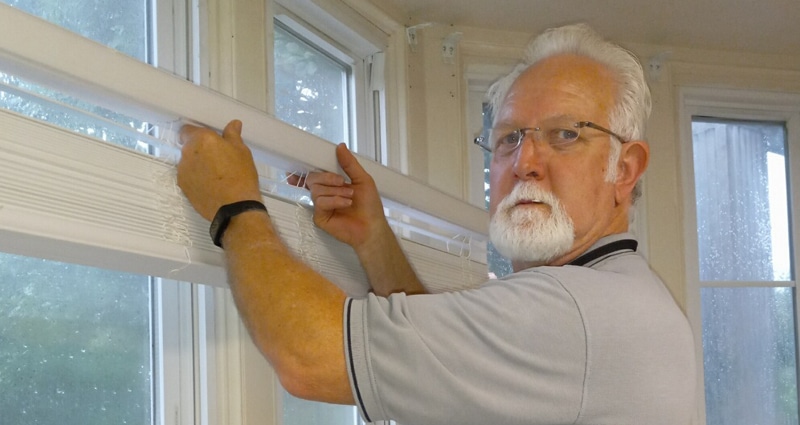Waking up to a stroke was a total surprise and life altering moment for Jeff Elliott, but immediate care from the team at St. Francis Medical Center got him on the road to recovery.
Elliott, now 66, was healthy and active, working long days at his maintenance job at St. Joseph Continuing Care and additional hours doing repair and construction work for family and friends.
“For my age, I was probably in the best health of anyone you would meet,” Elliott says. Other than a statin to manage high cholesterol, he was “healthy as a horse.”
Recognizing Stroke Symptoms
Elliott woke on September 15, a typical day, to get up for work.
“I rose up out of bed and had a funny feeling, a feeling I’ve never had before,” he says. “My right leg just didn’t want to act right. It was different than typical muscle spasms or cramps.”
Although it wasn’t painful, Elliott knew right away something was wrong as he made his way to the bathroom. Because of his work at a rehab and skilled nursing facility, Elliott recognized the signs of headache, nausea and losing the use of his right side. He yelled for his wife, Debbie, who works for St. Francis Primary Care Clinic, and told her he was having a stroke.
After a moment of shock and disbelief, Debbie called her daughter, a self-employed RN, and informed her of the situation. Her daughter alerted St. Francis that a possible stroke victim was on his way. The drive to the hospital from the small town of Start to Monroe took about 25 minutes.
“I threw up about three times on the way because the nausea was setting in,” Elliott says. “It was almost comical.” But it was also a very fraught and scary experience. The stroke team was waiting and ready when Elliott arrived.
Rapid Stroke Treatment
Care at St. Francis began immediately, and Elliott was seen by a neurologist and others on the team. A CT scan was done to make sure there was no bleed in the brain causing his symptoms. He was then taken immediately for an MRI of the brain. This allowed the stroke team to see that a stroke was indeed occurring in the left side of the brainstem, but that it had started very recently, likely within a few hours of when Elliot woke up.
Since the drug used to break up blood clots (tPA, or tissue plasminogen activator) can only be given within the first 4.5 hours of a stroke occurring, this emergent MRI was critical in allowing the stroke team to treat Elliot with tPA. After the tPA was given, Elliot was taken to the ICU for close monitoring.
“They hooked me up to the clot buster drug very quickly,” Elliott said. “That was another blessing in itself.” Fortunately, the stroke didn’t cause damage to Elliott’s memory or cognition, although he did temporarily lose speech. ”
Road to Recovery
After a stay in the ICU, Elliott was moved to a regular room until physical and occupational therapy could begin. Prayers surrounded him, including from his church, friends and family.
The doctors weren’t sure if he would regain control of his right side, and for five days he couldn’t move a finger or toe on that side. Elliott spent time willing a finger to move, and finally was able to flick his index finger just a quarter of an inch.
“I tell people now their prayers were answered,” he says. “Maybe it wasn’t a miracle, but my prayer was answered.”
Elliott is a very determined person, and he retrained himself to use his left hand to eat, brush his teeth and hair, and shave while also working with physical and occupational therapists to regain use on his right side.
Of his therapists, Elliott says, “The team was wonderful, that’s all I can say.” The work he put in paid off, and when he was discharged on October 7, Elliott estimates he probably had regained 30% to 40% usage of his right side.
Continuing to Improve at Home
Elliott transitioned to out-patient rehab at the St. Francis Community Health Center, and his stamina and endurance have continued to increase. By December he had returned to work part-time, four hours per day, and in February he began working six hours each day. He hopes to soon return to full-time work.
Although his dexterity has returned enough that he can handle nuts, bolts, drills and other things in his day-to-day work, Elliott’s control for playing music — he is a bass and guitar player — is not yet back fully. But he is able to do some music gigs for assisted living residents.
Elliott keeps at his therapy and working out to strengthen his muscles and avoid any atrophy. He also credits his health and recovery to his regular use of supplements.
Advice and Encouragement
“A lot of people ignore the symptoms and don’t know what’s happening until it’s too late or wait too long,” Elliott says. A stroke is different for each individual victim. Don’t wait if experiencing any stroke-like symptoms.
For other recovering stroke patients, Elliott advises them to “KEEP ON KEEPING ON” and use their muscles, hands and fingers.
“Concentrate on what you can do, not what you can’t. If you can’t even move a hand, use your good hand to force it to stretch out,” he says. “Don’t give up before you even get started. You can’t give up. That would be my encouragement.”
As his recovery continues, when asked how he’s doing Elliott often responds, “I’m better than yesterday but not as good as tomorrow.” His optimism remains as he continues to see daily improvements, be it in speech, physical strength or endurance to work longer days.




